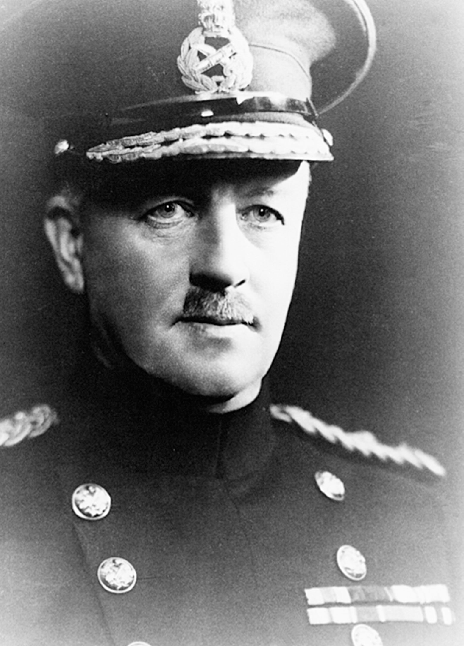 Dr Rupert Major Downes CMG VD MD MS KStJ was born in Melbourne in 1885, son of Major-General Major Francis Downes, final commandant of the Victorian Colonial Army. He was educated at Haileybury College and the University of Melbourne, graduating MB BS in 1907.
Dr Rupert Major Downes CMG VD MD MS KStJ was born in Melbourne in 1885, son of Major-General Major Francis Downes, final commandant of the Victorian Colonial Army. He was educated at Haileybury College and the University of Melbourne, graduating MB BS in 1907.
As a student Downes served in the Melbourne University Rifles, and in July 1908 he was commissioned as a captain in the Australian Army Medical Corps. After graduation he was occupied in private practice, in teaching as a demonstrator in anatomy at the University of Melbourne, in tutoring at Ormond College, and working as a clinical surgical assistant at the Melbourne and Children’s Hospitals. In 1911 he obtained the MD higher degree in medicine. In 1912 he was successful in the examination for the Master of Surgery degree in the University of Melbourne. At the same time, he threw himself into the work of the Australian Army Medical Corps, being promoted major in 1913.
With the outbreak of war in 1914 he joined the Australian Imperial Force and went abroad. He was promoted lieutenant-colonel, the youngest in the AIF. He led the 3rd Light Horse at Gallipoli. On the formation of the Anzac Mounted Division in March 1916, Downes became its Assistant Director of Medical Services with the rank of colonel.
When General Harry Chauvel formed the Desert Mounted Corps in 1917 Downes was appointed Assistant Director of Medical Services of the Desert Mounted Corps, and also Assistant Director of Medical Services of the Australian Empire Force (Middle East), based in Egypt, successfully combining the two roles for the remainder of the war. He was mentioned in dispatches six times. In January 1918 he was awarded the C.M.G.
After the War he was invited to write the section on the Sinai and Palestine campaign in Volume I of the Official history of the Australian Army Medical Services. He became an honorary consulting surgeon at the Children's and Victorian Eye and Ear hospitals, honorary surgeon at Prince Henry Hospital, and in 1927 a foundation fellow of the College of Surgeons of Australasia.
Outside his heavy military commitments, Downes was also extraordinarily energetic. He served on the Victorian Branch Council of the British Medical Association for many years and was elected President in 1935. He was Commissioner of St John Ambulance Brigade in Victoria from 1921 until his death in 1945. For many years he was a member of the Board of Victorian Civil Ambulance Service and was President for the years 1937-1938. He was chairman of the Masseurs' Registration Board, a councilor of the Victorian division of the Australian Red Cross, and chairman of the Red Cross National Council in 1939. In 1937 he was invested as a Knight of Grace in the Order of St John.
In 1921 he was a member of the committee planning reorganisation of the Army Medical Service and the employment of the profession during an emergency. He was also appointed Deputy Director of Medical Services, 3rd Military District (Victoria). Downes was appointed Director General of Army Medical Services in August 1934 and was promoted major general next year. In the five years to the outbreak of war in 1939, Downes selected and trained many leaders of the Australian Army Medical Corps, foresaw civil as well as military medical problems, planned their solution and pioneered major developments in the medical side of recruitment. He was chairman of the board which in 1935 reorganised army medical equipment. On his initiative funds were provided in 1939 in time to import large quantities of drugs such as quinine, and equipment before war began. It also encouraged local manufacture of many other items of equipment.
Downes began to press for the building of major military hospitals in the capital cities. He argued that after the war they should be handed over to the Repatriation Commission for the care of sick and disabled ex-service people. Time vindicated his judgment: the great hospitals such as Concord and Heidelberg are Rupert Downes's memorial.
He revolutionised the medical side of recruiting for the Australian Imperial Forces. Radiography of the chest was introduced, by means of fluorographic screens photographed on miniature film, and everyone was x-rayed. Every soldier's blood group was determined and recorded on his identity discs and all were inoculated against tetanus, smallpox, typhoid and paratyphoid fevers. Downes was also concerned that volunteers should be medically examined under proper conditions.
When Blamey reorganised the army in March 1942, he made Burston Director General of Medical Services. Downes went to the Second Army as Director of Medical Services. He was subsequently appointed Inspector-General of medical services by the minister of the army, (Sir) Percy Spender,
He was actively engaged in this way when he decided to accompany Major General George Vasey to New Guinea to see for himself the front-line conditions in this special phase of warfare. On 5th March 1945, in a severe thunderstorm, the RAAF Hudson carrying Vasey, Downes and another nine high-ranking military officers, crashed in the sea north of Cairns, killing all on board. They were buried, with full military honours, in the military section of Cairns Cemetery.
His loss was mourned by all the organisations he had served. The Royal Australasian College of Surgeons established the triennial Rupert Downes Memorial Lecture in his honour.
Last updated: 25 December 2024
Main source: “Surgeon and General”, Ian Howie-Willis, Australian Military History, 2008.
Article by Dr Allan Mawdsley OAM
